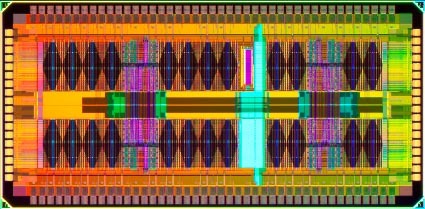IBM claims new eDRAM will double processor performance
San Francisco (CA) - IBM today revealed first data about a new embedded DRAM device, which the company claims achieves record access times. The technology is expected to debut in 2008 as part of the 45 nm generation of IBM processors.
According to the company, the eDRAM chip "vastly improves microprocessor performance in multi-core designs and speeds the movement of graphics in gaming, networking, and other image intensive, multi-media applications." Shown as a 65 nm concept at the currently held International Solid State Circuits Conference (ISSCC), IBM claims that the eDRAM exceeds the performance of conventional SRAM, which is typically used for on-die CPU cache, in about one-third the space with one-fifth the standby power.
DRAM's history goes back to 1970 and was driven since then mainly by cost factors, while logic technologic has received a more performance-focused evolution. IBM said that this environment has led to a widening gap between slower memory and faster logic devices, which resulted in a need for increasingly complex levels of memory hierarchies. Today, "DRAM can provide six to eight times as much memory as SRAM in the same area, but has been too slow to be used at any cache level," IBM said.
With a random cycle time of 2 ns and a latency of 1.5 ns, IBM now is convinced that DRAM is ready to be integrated into the CPU with the goal to replace SRAM. "With this breakthrough solution to the processor/memory gap, IBM is effectively doubling microprocessor performance beyond what classical scaling alone can achieve," said Dr. Subramanian Iyer, distinguished engineer and director of 45 nm technology development at IBM, in a prepared statement. "As semiconductor components have reached the atomic scale, design innovation at the chip-level has replaced materials science as a key factor in continuing Moore's Law."
eDRAM so far has been used in applications ranging from supercomputing to gaming. For example, IBM's BlueGene/L system uses eDRAM as L3 cache technology, while game consoles such as the Gamecube, the Xbox 360 and the Wii have been using eDRAM as embedded memory technology for their graphics processors. Compared to conventional DRAM modules, integrating DRAM has provided a key advantage of performance gains eliminating the need to drive I/O signals to external memory chips. eDRAM manufacturers such as NEC also believe that the technology will make its way into mobile application due to the low power consumption of eDRAM devices.
Get Tom's Hardware's best news and in-depth reviews, straight to your inbox.
Tom's Hardware is the leading destination for hardcore computer enthusiasts. We cover everything from processors to 3D printers, single-board computers, SSDs and high-end gaming rigs, empowering readers to make the most of the tech they love, keep up on the latest developments and buy the right gear. Our staff has more than 100 years of combined experience covering news, solving tech problems and reviewing components and systems.

